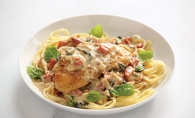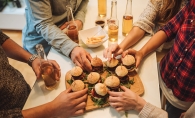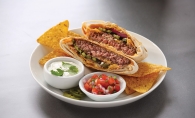
“Why are you making a turkey? Half your guests are vegetarian!” my mother said to me as I slaved away in the kitchen last Thanksgiving.
“Mom, it’s my Thanksgiving dinner. I made them a tofu curry. But I want a turkey and a beef tenderloin,” I replied. Besides, it was 2 in the afternoon and after hours of cooking, there was no turning back. My turkey was in the giant roaster that I only bring out once a year, my oven full of mashed potatoes, sweet potatoes with the marshmallows on top, green beans with almonds and the French’s fried onions, homemade cranberry sauce, and gravy. The muffin pan was ready for my hybrid Yorkshire pudding popovers. The result of my stubbornness was a half-eaten turkey. But I loved my meal. I felt satisfied that I ticked all my holiday boxes. But did I really have to do that? Why couldn’t I let go of the idea of a turkey dinner with all the trimmings on Thanksgiving?
Two local experts say I’m not alone— and that we don’t have to stick to tradition.
In fact, it has all of us in a vice grip.
“The typical holiday mentality is tradition. ‘I have to eat turkey and stuffing and sweet potatoes.’ It’s as if there aren’t other options available,” says Ann Marie Cimperman, nutritional coach at UpLift Fitness. “There are a lot of exciting ways to look at it differently and try to come up with healthier, more modern approaches to holidays. Just because the tradition exists doesn’t mean it’s a law. It’s not a rule that we must sit and eat turkey and stuffing and sweet potatoes.”
The first step for those who can’t shake tradition is to make subtle changes. “You can say, ‘We’re going to have sweet potatoes, but we’ll do something cool and different.’”
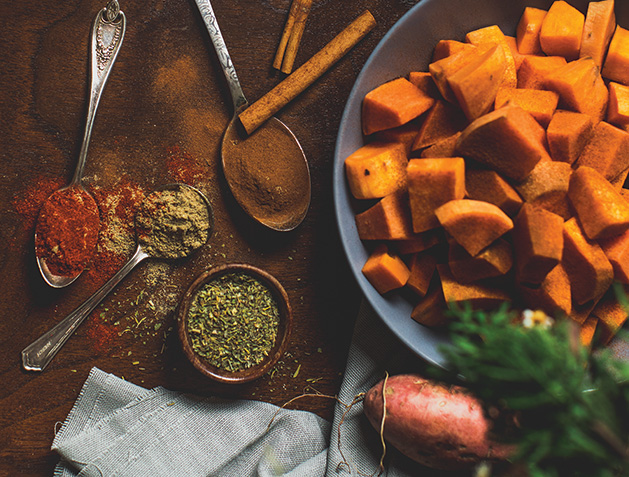
When cooking traditional foods in a new way, she recommends a unique take-home gift for guests.
“When I’ve hosted people and make recipes that are outside the standard box of stuffing from the store, I print out the recipes and I keep them in a drawer. They say, ‘Oh my gosh, it’s good!’ It helps people see there are healthy options available.”
Cimperman says when people expect a traditional meal and a host suddenly says they’re going to serve a healthy one instead, they imagine the worst. “People aren’t going to be eating dry chicken, steamed vegetables and salad with no dressing. That’s what people fear,” she says.
To get around that fear, she recommends having guests join in on the fun. Explain to them that you’re starting some new traditions. Cimperman recommends turning holiday meals into more of a potluck, where the host makes the main dish and encourages guests to bring side dishes.
“If we’re talking about Thanksgiving, it’s the kick-off of the six-week period where people have a tendency to go off the rails. Say, ‘I don’t want to start the season like this and sign up for eating poorly. I want to start the season healthy. Can you help?’ Asking people to help you do that, normally people will respond to that. As opposed to saying, ‘I’m serving a healthy meal.’ It comes across as negative and pushy. Reframe it as, ‘We are looking for healthy alternatives to foods we already loved.’”

Amy Goetz, FoodE expert at Lunds & Byerlys, says traditional recipes can be tweaked to fit current diet trends. For turkey on a Keto diet, she recommends adding bacon.
“I tuck bacon underneath my turkey skin and then you can use olive oil. That’s fine on Keto,” she says. “You’re adding some good flavor to it and I usually do herbs on the outside.”
For stuffing, Goetz recommends using cauliflower instead of bread.
“Cauliflower, onions, pine nuts and mushrooms,” she says. “Roast those on the side at super high heat or sear them in a pan to get that caramelization started and stuff the turkey with that.”
Cimperman says stuffing can also be made with gluten-free bread.
“Stuffing is all about the flavor profile: the herbs. That’s one of the easier ones to re-create that serves the same purpose. It’s an emotion around the food. We see it, we smell it, and if it’s a reasonable enough facsimile, it fits,” she says. “Similar to the stuffing is sweet potatoes. The cinnamon and the cardamom that goes in there—those can also be re-created. With sweet potatoes, you slice them chunky and you put ghee or some sort of fat. Give guests the option of drizzling honey and maple syrup on it. Most foods, if they’re really well cooked and the spice profile is right, you don’t need a lot of sugar on them.”
As for gravy, Goetz recommends Keto diet followers use butter instead of flour.
“If you make a pat of cold butter in the pan, you’re making a sauce and adding herbs to that to make a thin au jus for the turkey. You’re not adding in all of the flour and things like that,” she says. And if you are using her bacon under the skin turkey recipe, even better. “The fat that comes from adding it to the turkey makes an incredibly flavorful sauce.”
Goetz recommends making as many items as you can on your own. That means avoiding anything boxed or prepackaged.
“When you buy the convenience food, it’s pre-seasoned and going to have a lot of salt,” she says. While the task seems daunting, she insists cooking ahead of time will help with getting ready for the meal.
“Buy that loaf of bread four days before and let it dry out for stuffing. Save the bones from the rotisserie chicken and make your own broth from that. Or when the turkey is cooking, put the giblets on the stovetop with low temperature. You’re making more flavor without the extra salt and ingredients,” Goetz says.
Stuffing and broth are just a few things cooks can make ahead of time.
“Food safety rules give you three to five days. You can make some of those things three days ahead of time. On Monday night after work, you can take a loaf of bread and cube it up and let it stay out on the counter for a day or two, and then throw it into a Ziploc baggie so you’re one step ahead,” she says. “Two weeks ahead of time you want to make some broth and throw it into a crock pot and stew it all day. Throw the bones in there; throw in all of your carrots and onions and celery and herbs like thyme and parsley. I always throw in five or six little peppercorns and not much else than that, and top it all with water and let it sit on a low setting.”
Goetz says to let it cool all the way down. Then, freeze it until the big day.
“It will have a little more fat than the canned stuff. It’s going to be decent on sodium and perfect for making your own gravy,” she says. “You’ll have to salt to taste when you make it.”
For dessert, Goetz says a good substitute for pie is a pumpkin soufflé or even just simple fruit. If you get stuck, Cimperman says there’s always Google.
“You can Google recipes that either have or have not just about anything,” she says. “This past Thanksgiving, our family has somebody who is gluten-free, we have a vegan in there. And we have kids who say, ‘I don’t want your vegan food.’ I found a stuffing recipe that was vegan as well as gluten-free. I had to buy the gluten free bread. But so many of those things are at stores.”
She says it’s okay to try new things.
“If we’re still getting together with friends and family and sharing a meal together, that’s the purpose of those traditions, not necessarily the food.”
Perhaps I’ll leave the turkey roaster in the cupboard this year.
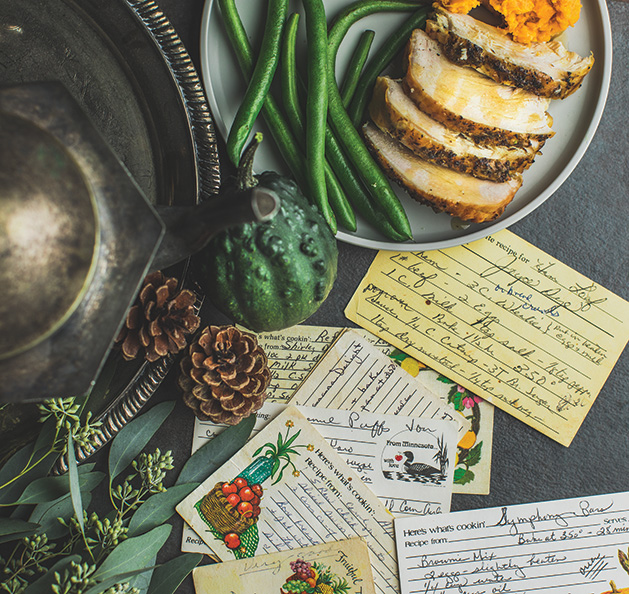
Find some great Thanksgiving recipes from our foodie and nutrition experts below.
Savory Walnut Loaf by Lunds & Byerlys
Ingredients:
- 1 Tbsp. olive oil
- 6 cups water
- 2 ½ cups organic short grain brown rice (must be short grain brown rice to hold loaf together)
- 3 cups walnuts, finely chopped
- 2½ cups sharp cheddar, grated
- 4 extra large organic eggs
- 1 medium onion, diced
- 1 Tbsp. garlic, minced
- ½ cup sesame seeds, toasted
- 2 Tbsp. flax, ground
- ⅓ cup tamari
- ¼ cup Bob’s Red Mill nutritional yeast flakes
- 1 tsp. black pepper
- 1 tsp. sea salt
- 1 Tbsp. Spike salt-free seasoning
Preheat oven to 350° F. Brush 9 x 12 baking dish with olive oil. Boil water in large pot with lid. Add rice, stir and bring to boil again. Reduce heat to low and cook covered for 20-25 minutes. Turn off heat and let sit covered for 30 minutes. Rice should be well cooked and slightly sticky. Cool rice to room temperature. In large bowl, combine rice with all remaining ingredients and mix well. Lightly press into prepared pan. Bake for 40-50 minutes or until internal temperature measures 145° F with cooking thermometer. Serve with marsala mushroom gravy (recipe below).
Servings: 15
Flourless Deglazed Turkey Butter Sauce by Amy Goetz
Ingredients:
- 1-2 sprigs fresh thyme
- 1 shallot, finely minced
- 2 cups broth, turkey or chicken, warmed
- 4 Tbsp. cold unsalted butter, cut into small pieces
- Salt and pepper to taste
Remove turkey from the oven, cover with a tent of foil and allow to stand for 15 to 20 minutes. This will help juices from the turkey to redistribute, but will also let some of the juices drip into the pan. After resting, move the turkey to a carving platter. Pour off the fat from the pan and put pan over medium heat. Add the shallot and thyme, and cook until the shallot has softened. Add the broth and, using a whisk, scrape up the browned bits off the bottom of the pan. Cook until the liquid reduces slightly, about 4-6 minutes. Remove from heat and whisk in the cold butter, one piece at a time until combined. Serve immediately.
Servings: 4-6
Marsala Mushroom Gravy by Lunds & Byerlys
Ingredients:
- 2 tbsps organic extra virgin olive oil
- 1 medium onion, diced
- 1 tbsps garlic, minced
- 8 oz crimini mushrooms, lightly washed, stems trimmed
- 8 oz button mushrooms, lightly washed, stems trimmed, diced
- ½ tsp sea salt
- ½ teaspoon black pepper
- ½ cup Marsala cooking wine
- 3 tbsps organic butter
- ⅓ cup flour
- 2½ cups organic vegetable broth
- 2 tbsps organic tamari
- 1 tbsp lemon juice
- ¼ cup Italian parsley, chopped
Over medium-high heat, sauté olive oil, onion and garlic until onions are translucent. Add mushrooms, salt, pepper, sauté for 10 minutes or until tender. Cook mushrooms for another 10 minutes until juices have almost evaporated. Add Marsala wine and cook 3-4 minutes, stirring to deglaze pan and reduce Marsala slightly. To make the roux, in separate saucepan melt butter over medium heat. Heat butter until flour bubbles when added then slowly whisk in the remaining flour. Continue to cook and whisk butter and flour for 3- 4 minutes to remove starchy flavor of flour. Slowly whisk in vegetable broth, tamari and lemon juice. Add roux to cooked mushrooms. Stir in parsley and enjoy!
Autumn Apple Bruschetta by Amy Goetz
This crisp reminder of a perfect fall day can be served on toasted baguette slices (recipe below), on top of roasted slices of sweet potato, or tossed with greens for a delicious salad.
Ingredients:
- 2 crisp/tart apples (SweeTango or Honeycrisp)
- 1 tbsp fresh basil, chopped
- 3 tbsps Raspberry Vinegar (or other fruit flavored vinegar)
- 3 tbsps walnut or sunflower oil, divided
- 1 bake-at-home baguette, unbaked
- 4 oz chèvre/fresh goat cheese
Chop apples into small pieces and toss with basil, vinegar and 2 tsps oil. Set aside for at least 20 minutes. Stir before serving. Slice the unbaked baguette, brush the slice with remaining oil and brown in a skillet. May be served warm, or cool before serving. Serve topped with a little chèvre and a spoonful of the apple mixture. Tip: Chèvre is a perfect combination of creamy and tangy, which balances out the sweetness of the apple mixture. Brie would also be delicious for this bruschetta. For a caramel apple twist, use a slice of the Norwegian cheese, Gjetost, on the browned baguette. Tip: The apple mixture can be refrigerated for up to one day. The color will darken a little (due to the natural discoloration of the apples), and the apples won’t be as crispy, but it is still delicious. The baguettes, on the other hand, need to be made fresh and served immediately.







